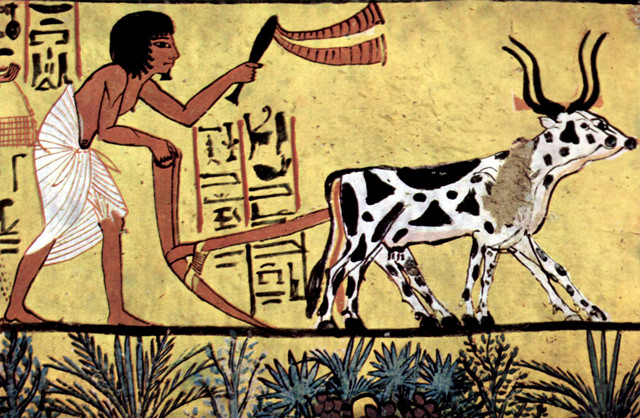
by Adityarup "Rup" Chakravorty Thursday, November 8, 2018

A new study indicates that animal husbandry and agriculture starting about 8,000 years ago (depicted here in a painting from the burial chamber of the Egyptian artist Sennedjem from about 3,300 years ago) postponed the next glacial period. Credit: public domain.
During the last 2.5 million years, Earth’s climate has seen cycles of advancing and retreating glaciers over much of the Northern Hemisphere. We are currently in a warm, interglacial period — one that’s been prolonged by increases in atmospheric concentrations of greenhouse gases, such as carbon dioxide and methane. According to a new study in Nature, these high concentrations of greenhouse gases have disrupted the recent pattern of cycling in Earth’s climate and pushed back the next ice age. The study also suggests that human activity, beginning thousands of years ago with early agriculture and continuing through to the present day, has fueled the rise in greenhouse gas concentrations.
“Greenhouse gas emissions from early agriculture fortuitously postponed the start of the next glacial period,” says Stephen Vavrus, a climatologist at the University of Wisconsin-Madison and lead author of the study published in Scientific Reports. “But the additional emissions from human activity, especially since the industrial revolution, have moved us way out of whack from where we ought to be [in the natural climate cycle].”
The idea that early agriculture increased atmospheric greenhouse gas concentrations and affected global climate starting about 8,000 years ago is called the Early Anthropogenic Hypothesis. This hypothesis was first proposed in 2003 by William Ruddiman, an emeritus paleoclimatologist at the University of Virginia and a co-author of the new study.
In the new study, Ruddiman, Vavrus and their colleagues compared climate models of the global climate in 1850 — around the time greenhouse gas emissions began accelerating because of the industrial revolution — to the climate about 780,000 years ago. They selected these two periods because a couple of major natural drivers of global climate — the shape of Earth’s orbit around the sun and the tilt and wobble of Earth’s rotational axis — were similar at these times, so the climates also should’ve been broadly similar.
Comparing global climate in 1850 to that 780,000 years ago — when human agriculture and industry did not exist — would “allow us to test what the climate would be like without anthropogenic greenhouse gas emissions from early agriculture,” Vavrus says.
According to the team’s climate simulations, the global climate was much colder about 780,000 years ago — during a period called marine isotope stage 19 (MIS19) — compared to in 1850 (which falls in MIS1). Average temperatures were about 1.3 degrees Celsius lower globally while parts of the High Arctic were as much as 5 to 6 degrees Celsius colder. Permanent snow cover also extended farther south in MIS19, with almost 10 million square kilometers predicted to be under snow throughout the year compared to less than 6 million square kilometers in 1850.
A key difference in environmental conditions during MIS19 and MIS1 — which started about 11,500 years ago — is how the concentration of greenhouse gases like carbon dioxide and methane changed over time. The researchers used ice-core data to reconstruct levels of greenhouse gases during MIS19 and MIS1. They also examined past interglacial periods to predict what present-day carbon dioxide levels may have been in the absence of human activities.
During MIS19, which lasted from about 788,000 to 776,000 years ago, both carbon dioxide and methane concentrations decreased overall. Levels of these gases also decreased during the early millennia of MIS1, but carbon dioxide levels started rising about 7,000 years ago and methane levels did the same about 5,000 years ago.
Vavrus says that a combination of early agriculture and breeding and maintaining farm animals, along with deforestation to clear land for those activities, would have led to those increases in greenhouse gas emissions.
Julie Brigham Grette, a paleoclimatologist at the University of Massachusetts Amherst who was not involved in the study, agrees. “This study cleanly demonstrates the magnitude of human influence on our planet, beginning with the start of agriculture in the early Holocene as postulated by Ruddiman,” she says. “It adds to a growing body of scientific evidence that small changes in our planet’s greenhouse gas chemistry can have dramatic implications on the climate.”
While the actions of early farmers may have initially postponed the next glacial period, the rapidly increasing concentrations of greenhouse gases in the atmosphere during modern industrial times are alarming, Vavrus says.
Indeed, Brigham Grette says, and “this study puts into context the extreme nature of human influence today with carbon dioxide concentrations in the atmosphere now in excess of 405 parts per million — more than 120 parts per million above pre-industrial levels.”
© 2008-2021. All rights reserved. Any copying, redistribution or retransmission of any of the contents of this service without the expressed written permission of the American Geosciences Institute is expressly prohibited. Click here for all copyright requests.